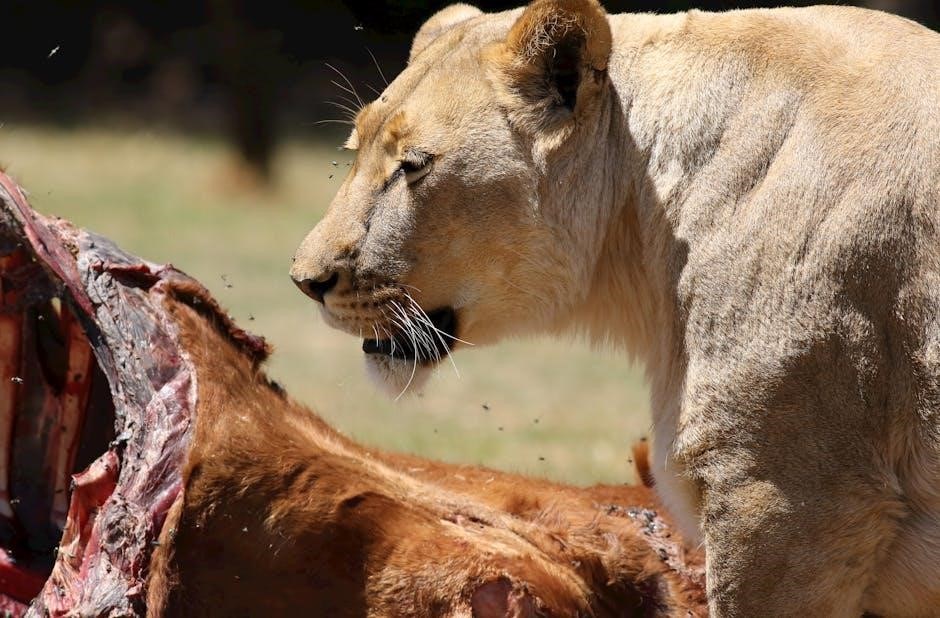This timeless fable by Aesop explores the unlikely friendship between a mighty lion and a tiny mouse, highlighting themes of kindness, bravery, and the power of reciprocity in relationships.
1.1. Overview of the Fable
Aesop’s “The Lion and the Mouse” is a timeless fable that narrates the story of an unlikely friendship between a mighty lion and a tiny mouse. The lion, initially amused by the mouse’s bravery, spares its life after the mouse promises to repay the kindness. Later, when the lion is trapped in a hunter’s net, the mouse returns the favor by chewing through the ropes, freeing the lion. This simple yet profound story highlights themes of mercy, gratitude, and the idea that even the smallest creatures can make a big difference. Its universal appeal has made it a beloved tale across generations, often shared in various formats, including PDF, for easy access and reading.
1.2. Importance of the Story in Literature
Aesop’s “The Lion and the Mouse” holds a significant place in world literature, offering timeless moral lessons that transcend age and culture. Its simplicity and universal themes make it accessible to readers of all backgrounds. The story emphasizes the value of kindness, gratitude, and reciprocity, teaching that even the smallest acts of compassion can have profound effects. It serves as a powerful tool for moral education, particularly for children, and its concise narrative has made it a popular choice for adaptations in various formats, including PDFs. The fable’s enduring relevance underscores its importance in literary traditions, reinforcing the idea that size and strength are not the only measures of worth.

Background of Aesop and His Fables
Aesop, a Greek storyteller from the 6th century BC, is renowned for his timeless fables, which convey moral lessons through simple narratives involving animals. His stories remain foundational in literature and education.
2.1. Who Was Aesop?
Aesop, a Greek storyteller believed to have lived in the 6th century BC, is celebrated for his fables that teach moral lessons. Though his life details are scarce, his wisdom endures through stories like “The Lion and the Mouse,” highlighting themes of kindness and reciprocity. His works have become foundational in literature, offering insights into human nature and ethics. Aesop’s legacy is profound, making him one of the most influential storytellers in history, with his fables remaining relevant across generations and cultures.
2.2. Historical Significance of Aesop’s Fables
Aesop’s fables hold immense historical significance as they have shaped moral education and storytelling across centuries. These simple yet profound tales, including “The Lion and the Mouse,” have transcended time and culture, offering universal lessons on ethics and human behavior. Their enduring popularity lies in their ability to convey complex ideas through relatable narratives, making them accessible to diverse audiences. As a result, Aesop’s fables have influenced literature, art, and education, becoming a cornerstone of cultural heritage. Their timeless wisdom continues to inspire, ensuring their relevance in modern society.

The Plot of “The Lion and the Mouse”
The story revolves around a lion who spares a mouse’s life after the mouse begs for mercy. Later, the mouse repays the kindness by freeing the lion from a hunter’s net, proving even small acts of kindness can have significant impacts.
3.1. The Lion’s Character and Role
The lion, often portrayed as the mighty king of the forest, embodies both strength and mercy. His powerful build and majestic mane symbolize his dominance, yet his actions reveal a deeper complexity. Initially amused by the mouse’s bravery, the lion decides to spare its life, showcasing his noble and compassionate side. This act of kindness underscores his role as a protector rather than just a fearsome predator. The lion’s character evolves from a fearsome figure to a gracious ruler, highlighting the duality of power and humility. His decision to let the mouse go sets the stage for the reciprocal relationship that defines the story’s moral core.
3.2. The Mouse’s Bravery and Resourcefulness
The mouse, despite its small size, demonstrates remarkable bravery and resourcefulness. When caught by the lion, the mouse pleads for mercy and promises future repayment, showing quick thinking under pressure. Later, upon hearing the lion’s distress, the mouse bravely ventures to free him from a hunter’s net. Using sharp teeth, the mouse meticulously chews through the ropes, proving that even the smallest creatures can make a significant impact. This act of bravery not only saves the lion but also highlights the mouse’s loyalty and ingenuity, dispelling stereotypes about size and strength. The mouse’s actions exemplify how courage and cleverness can overcome seemingly insurmountable challenges, making it a memorable and inspiring character in the fable.
3.3. The Key Events in the Story
The story begins with a lion catching a mouse in the forest. The mouse pleads for mercy, promising to repay the lion’s kindness someday. Amused by the mouse’s bravery, the lion spares its life and releases it. Later, the lion is trapped in a hunter’s net and roars for help. The mouse, hearing the lion’s cries, bravely returns and chews through the ropes, freeing the lion. This act of loyalty and resourcefulness proves that even the smallest creatures can make a big difference. The lion, grateful for the mouse’s help, acknowledges the importance of their friendship, highlighting the moral that kindness and reciprocity know no bounds of size or strength.

Themes and Moral Lessons
The story emphasizes kindness, friendship, and the idea that even the smallest actions can make a big difference, teaching that size and strength are not the only measures of importance.
4.1. Kindness and Mercy
The lion’s decision to spare the mouse exemplifies kindness and mercy. Despite the mouse’s small size, the lion chose compassion over cruelty, demonstrating that even the most powerful can show grace. This act of mercy set the foundation for an unlikely friendship, proving that kindness can lead to unexpected rewards. The mouse’s gratitude and subsequent bravery further highlight the transformative power of mercy. The story teaches that kindness is a universal language, transcending size and strength, and that even the smallest creatures can repay kindness in meaningful ways. This moral remains timeless, emphasizing the importance of treating all beings with compassion and understanding.
4.2. Friendship and Reciprocity
The story of “The Lion and the Mouse” beautifully illustrates the power of friendship and reciprocity. When the lion spares the mouse’s life, he sets in motion a chain of events that ultimately benefits both characters. The mouse, despite its small size, repays the lion’s kindness by freeing him from the hunter’s net. This mutual exchange highlights the importance of reciprocity in relationships, showing that even the most unlikely of friends can support one another. The tale emphasizes that true friendship knows no bounds of size or strength and that small acts of kindness can lead to significant rewards. This moral teaches readers to value and nurture friendships, as they can bring unexpected joy and support in times of need.
4.3. The Idea That Size Doesn’t Matter
The fable of “The Lion and the Mouse” underscores the idea that size does not determine one’s ability to make a difference. Despite the lion’s immense power and the mouse’s small stature, their roles reverse when the mouse bravely frees the lion from a hunter’s net. This reversal challenges stereotypes about strength and capability, proving that even the smallest creatures can have a significant impact. The story teaches that everyone, regardless of size or status, has the potential to help others in meaningful ways. This moral emphasizes equality and the value of all individuals, encouraging readers to look beyond physical appearances and recognize the unique contributions each being can offer.

Characters in the Story
The story features two main characters: the lion, a mighty king, and the mouse, a brave and loyal friend. Their friendship highlights kindness and reciprocity.
5.1. The Lion: The Mighty King of the Forest
The lion is portrayed as the powerful king of the forest, symbolizing strength and dominance; His majestic presence commands respect, and his roar echoes through the land, striking fear into the hearts of other animals. Despite his fearsome reputation, the lion shows unexpected mercy when he spares the life of a tiny mouse. This act of kindness highlights his noble character and sets the stage for the mouse’s eventual reciprocation. The lion’s role in the story emphasizes the importance of compassion and understanding, proving that even the mightiest creatures can show humility and grace. His interaction with the mouse serves as a pivotal moment, teaching valuable lessons about friendship and gratitude.
5.2. The Mouse: The Brave and Loyal Friend
The mouse, though small and vulnerable, exhibits remarkable bravery and loyalty. Initially frightened by the lion, the mouse pleads for mercy and promises to repay the kindness. Despite his size, he courageously returns to help the lion when it is trapped, demonstrating that even the weakest can make a significant impact. The mouse’s actions showcase his resourcefulness and determination, proving that size is not a measure of one’s ability to help others. His loyalty and gratitude towards the lion highlight the importance of standing by those who have shown compassion, reinforcing the theme of friendship and reciprocity. The mouse’s character serves as a testament to the idea that everyone, regardless of their stature, can contribute meaningfully to the lives of others.

Cultural and Historical Impact
Aesop’s fable has transcended time, influencing cultures globally through its universal moral of kindness and reciprocity, featured in education and various adaptations, ensuring its lasting relevance.
6.1. The Story’s Popularity Across Generations
The fable of “The Lion and the Mouse” has endured for centuries, captivating audiences of all ages with its simple yet profound message. Its universal appeal lies in the timeless themes of kindness, gratitude, and the unexpected friendships between beings of different strengths. Across generations, the story has been retold in various forms, from classic literature to modern adaptations, ensuring its relevance remains unchanged. The availability of the story in formats like PDF has further enhanced its accessibility, allowing it to reach a broader audience and continue inspiring readers worldwide. This adaptability is a testament to the fable’s enduring charm and moral significance.
6.2. Adaptations in Literature and Media
The fable of “The Lion and the Mouse” has been adapted into various forms of literature and media, further cementing its place in cultural heritage. It has been retold in children’s storybooks, animated films, and even stage plays, each adaptation bringing its own unique interpretation while retaining the core moral. Additionally, the story has been incorporated into educational materials, such as PDF versions designed for classroom use, making it accessible to learners worldwide. These adaptations not only preserve the story’s timeless appeal but also introduce it to new generations, ensuring its relevance in modern times. The versatility of the narrative allows it to transcend traditional storytelling, engaging audiences through diverse mediums.

Educational Uses of the Story
The story is widely used in classrooms to teach moral lessons, language skills, and cultural values, with PDF versions available for easy access and learning.
7.1. Teaching Morals to Children
The story of “The Lion and the Mouse” is a powerful tool for teaching moral lessons to children. It emphasizes the importance of kindness, empathy, and reciprocity, showing how even the smallest acts of compassion can have a profound impact. Teachers use this fable to help children understand the value of friendship and the idea that everyone, regardless of size or strength, can make a difference. The simplicity of the narrative makes it accessible to young learners, while its deeper themes encourage critical thinking and discussion. By incorporating the story into curricula, educators foster moral development and social-emotional learning in a engaging and relatable way.
7.2. Use in Language Learning Materials
The story of “The Lion and the Mouse” is widely used in language learning materials due to its simple yet engaging narrative. Its clear moral and repetitive structure make it ideal for teaching vocabulary, grammar, and comprehension skills to learners of all ages. Educators often incorporate the fable into reading exercises, allowing students to practice fluency and pronunciation. Additionally, the story’s universality and relatable themes make it a valuable tool for cross-cultural communication. Its availability in PDF format ensures easy access for both teachers and students, facilitating its use in classroom settings or self-study programs. This fable is a timeless resource for language acquisition and cultural enrichment.

The Story in PDF Format
The Lion and the Mouse story is widely available in PDF format, offering easy access for reading, sharing, and educational purposes, enhancing its timeless appeal globally.
8.1. Availability of “The Lion and the Mouse” in PDF
The Lion and the Mouse story is readily available in PDF format, making it easily accessible for readers worldwide. Many websites offer free downloads, while others provide it as part of educational resources or anthologies of Aesop’s fables. The story can be found on platforms like Google Books, Scribd, and educational websites, ensuring its widespread reach. Additionally, PDF versions often include colorful illustrations, making it engaging for children and visually appealing for all readers. This accessibility has contributed to its popularity as a teaching tool in classrooms and homes alike.
Furthermore, the PDF format allows for easy sharing and printing, making it a convenient option for storytelling sessions or language learning materials. Its availability in digital form ensures that the timeless fable remains relevant and accessible to modern audiences.
8.2. Benefits of Reading the Story in PDF
Reading “The Lion and the Mouse” in PDF format offers numerous advantages. It provides convenient access to the story, allowing readers to enjoy it anywhere, anytime, without the need for physical copies. The digital format is environmentally friendly and cost-effective, making it a popular choice for educators and parents. PDF versions often include vibrant illustrations, enhancing the storytelling experience, especially for children. Additionally, the story can be easily shared and printed for classroom activities or bedtime reading. The portability and readability of PDFs ensure that the timeless moral lessons of the fable reach a broader audience, maintaining its relevance in the digital age.

Historical Context of the Fable
Aesop’s “The Lion and the Mouse” originates from ancient Greek oral traditions, emphasizing timeless moral lessons that have resonated across cultures and centuries.
9.1. Origins of the Story
Aesop’s “The Lion and the Mouse” has its roots in ancient Greek oral storytelling traditions. The fable is believed to have been passed down through generations before being documented in written form. Aesop, a storyteller from the 6th century BC, is credited with creating this and many other fables that convey moral lessons. The story’s simplicity and universal themes ensured its survival and adaptation across various cultures. Over time, it has been translated into multiple languages and remains a popular tale in children’s literature. Its origins reflect the cultural and historical context of ancient Greece, where fables served as tools for teaching ethics and wisdom. The story’s enduring appeal lies in its ability to transcend time and cultural boundaries, making it a timeless classic in world literature.
9.2. Evolution of the Narrative Over Time
Over centuries, “The Lion and the Mouse” has undergone subtle changes in its narrative while retaining its core moral message. Originally shared orally, the fable was later documented in written form, with variations emerging across cultures. Some versions emphasize the mouse’s bravery, while others highlight the lion’s mercy. Modern adaptations, including PDF formats, have made the story more accessible, incorporating illustrations and simplified language for younger audiences. Despite these changes, the essence of friendship and reciprocity remains intact. The story’s evolution reflects its adaptability to different eras and audiences, ensuring its timeless relevance in literature and education.

Psychological Insights from the Story
The fable highlights the psychology of gratitude and reciprocity, showing how small acts of kindness can lead to significant positive outcomes, challenging stereotypes about strength and weakness.
10.1. The Power of Gratitude and Reciprocity
The story underscores the profound psychological impact of gratitude and reciprocity. The mouse’s bravery in helping the lion, despite his size, exemplifies how small acts of kindness can have significant effects. The lion’s initial mercy and the mouse’s subsequent gratitude create a cycle of mutual respect, challenging stereotypes about strength and weakness. This dynamic highlights the emotional and moral value of reciprocity, emphasizing that even the smallest gestures can lead to profound positive outcomes. The fable teaches that kindness is never wasted and that helping others, regardless of their status, fosters meaningful connections and mutual benefit. This timeless lesson resonates deeply, encouraging empathy and cooperation in relationships.
10.2. Breaking Stereotypes About Strength and Weakness
The fable challenges traditional notions of strength and weakness, showcasing how even the smallest creatures can make a significant impact. The lion, symbolizing power, initially underestimates the mouse, yet the mouse’s bravery and ingenuity prove that size is not a measure of capability. This dynamic subverts the stereotype that might alone determines importance, emphasizing that even the weak can be mighty in their own way. The story encourages readers to look beyond physical strength and recognize the value of courage, wit, and determination. By doing so, it promotes a more inclusive understanding of strength, where everyone, regardless of size or status, has the potential to make a difference.
The Lion and the Mouse teaches kindness, friendship, and the idea that even the smallest can help the mighty, remaining a timeless, universal tale.
11.1. Summary of Key Points
The Lion and the Mouse is a timeless fable by Aesop, teaching valuable life lessons. The story revolves around an unlikely friendship between a mighty lion and a tiny mouse. Initially, the lion spares the mouse’s life, showcasing kindness and mercy. Later, when the lion is trapped, the mouse repays the favor by freeing him, highlighting the importance of reciprocity and the idea that even the smallest creatures can make a big difference. The fable emphasizes themes such as kindness, bravery, and the notion that size does not determine one’s ability to help others. These moral lessons have made the story a beloved tale across generations, transcending cultures and time. Its universal appeal continues to resonate, making it a significant part of literary heritage.
11.2. Final Thoughts on the Story’s Relevance
The Lion and the Mouse remains a timeless tale with universal appeal, offering lessons on kindness, reciprocity, and the idea that even the smallest actions can have a significant impact. Its relevance lies in its ability to transcend generations, cultures, and contexts, making it a cornerstone of moral education. The story’s simplicity and depth ensure its continued popularity, as it inspires reflection on the value of friendship and the importance of helping others. Its availability in PDF format further enhances its accessibility, allowing readers of all ages to engage with its enduring message. This fable, as a part of Aesop’s legacy, continues to resonate, reminding us of the power of compassion and the interconnectedness of all beings.

